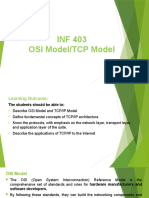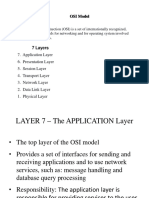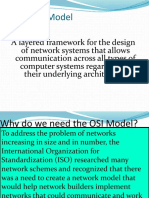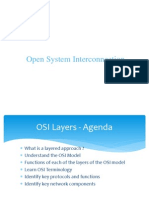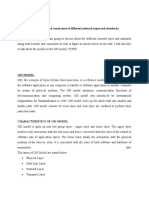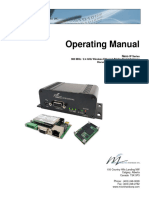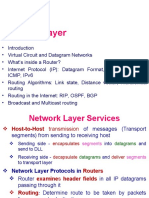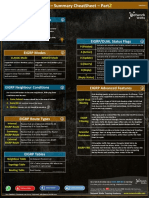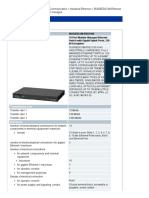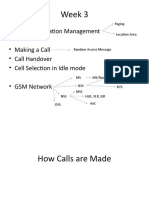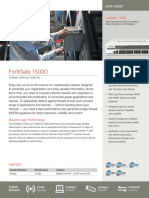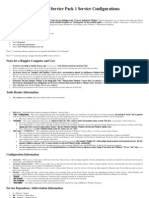Network protocol
OSI models and its Layers
Submitted by:
Nicole Dela Torre
Emil John Atangan
BSIS-3a/3b
�1. Network Protocol
• Set of rules that leads to communication between computers on network.
• It can be said that common network communication standard.
• The purpose of a network is to enable the sharing of files and information between multiple
systems.
• Network protocols include mechanisms for devices to identify and make connections with each
other.
• Some Important Protocols
Telnet, TCP/IP, HTTP, FTP, SMTP
2. What is Network Protocol?
• Protocol is a controlled sequence of message that is exchanged between two or more systems to
accomplish a given task.
• Protocol specifications define this sequence together with the format or layout of the message
that ate exchanged.
3. Network Structure
4. OSI Model
• Open Systems Interconnection Model (OSI Model)
• Model for computer communication architecture.
• Tools for understanding data communications between two network systems.
• Developed by ISO during 1977.
�5. Seven OSI Layers
Physical Layer
• Send bits from one computer to another.
• Media like Ethernet, Coaxial Cable, Token Ring, Hubs. Etc.
• Defines electrical and physical details represented as 0 or a 1.
Functions are
Representation of Bits
Data Rate
Synchronization
Line Configuration
Topologies
Transmission Modes (Half -Full duplex)
Data Link Layer
• Provide node to node delivery of the data.
• Divided into 2 sub layers:
Media Access Control (MAC): Maintains physical device address.
Logical Link Control (LLC): Synchronizing, error checking.
• Provides an error-free virtual channel to the Network Layer.
Functions are
Framing,
Physical Addressing
Flow Control
Error Control
Access Control
Network Layer
• Deliver packets from source to destination across multiple links (networks).
• Manage the logical addressing information in the packets of data from sender to receiver.
• Use Routers as network layer devices.
• Router use 2 layers of addressing: data link layer addressing for communications within the LAN and
network layer information for communications between LAN segments.
Functions are
Translates logical network address into physical address.
Control error
Breaks larger packets into small packets.
Transport Layer
• Delivered the entire message from source to destination.
• Breaks data into smaller packets.
Functions are:
Service Point Addressing
Segmentation and Reassembling
Connection Control
Flow Control
Error control
� Session Layer
• It establishes, maintains, synchronizes and manage interaction between communicating devices.
Functions are:
Session management
Synchronization
Dialogue control
Graceful close connecting between applications.
Presentation Layer
• Take care of the syntax of the information exchanged between two communicating systems.
Functions are:
Translation
Encryption
Compression
Security validating passwords and login codes
Application Layer
• Manipulation of data in various ways is done in this layer which enables user to get access to the network.
• The application layer enables the user, whether human or software, to access the network.
• Contains SMTP, FTP, HTTP etc.
Functions are:
Network virtual terminal
Directory Services
Mail Services
File Transfer
Access and Management
6. TCP/IP
• Stands for Transmission Control Protocol and the Internet Protocol.
• Developed by Defense Advance Research Project Agency (DARPA), 1960s.
• Set of Protocol that enable communication between computers.
• It is the two protocols commonly used by the Internet.
• Known as language of Internet
7. TCP/IP and OSI Model
• Like network model TCP/IP also has OSI Model.
• OSI has 7-layer standards but TCP/IP has 4-layer standards.
8. Four TCP/IP Layers
Application Layer
The application layer is concerned with providing network services to applications. There are many
application network processes and protocols that work at this layer, including HyperText Transfer
Protocol (HTTP), Simple Mail Transport Protocol (SMTP) and File Transfer Protocol (FTP).
� At this layer sockets and port numbers are used to differentiate the path and sessions which
applications operate. Most application layer protocols, especially on the server side, have specially
allocated port numbers, e.g. HTTP = 80 and SMTP = 25, and FTP = 20 (Control), 21 (Data).
Transport Layer
This layer is concerned with the transmission of the data. The two main protocols that operate at
this layer are Transmission Control Protocol (TCP) and User Datagram Protocol (UDP). TCP is
regarded as being the reliable transmission protocol and it guarantees that the proper data
transfer will take place. UDP is not as complex as TCP and as such is not designed to be reliable or
guarantee data delivery. UDP is generally thought of as being a best effort data delivery, i.e. once
the data is sent, UDP will not carry out any checks to see that it has safely arrived.
Internet Layer
This is the layer that contains the packet construct that will be transmitted. This takes the form of
the Internet Protocol (IP) which describes a packet that contains a source IP Address, destination
IP Address and the actual data to be delivered.
Network Access Layer
This is the lowest level of the TCP/IP protocol stack and functions carried out here include
encapsulation of IP packets into frames for transmission, mapping IP addresses to physical
hardware addresses (MAC Addresses) and the use of protocols for the physical transmission of
data.
9. Features of TCP/IP
a) Using around 35 years. It is most widely used protocol
b) Multi-vendor supports
c) Interoperability(multi-platform)
d) Logical Addressing.
e) Routability
f) Name resolution
g) Error control and flow control. etc.



